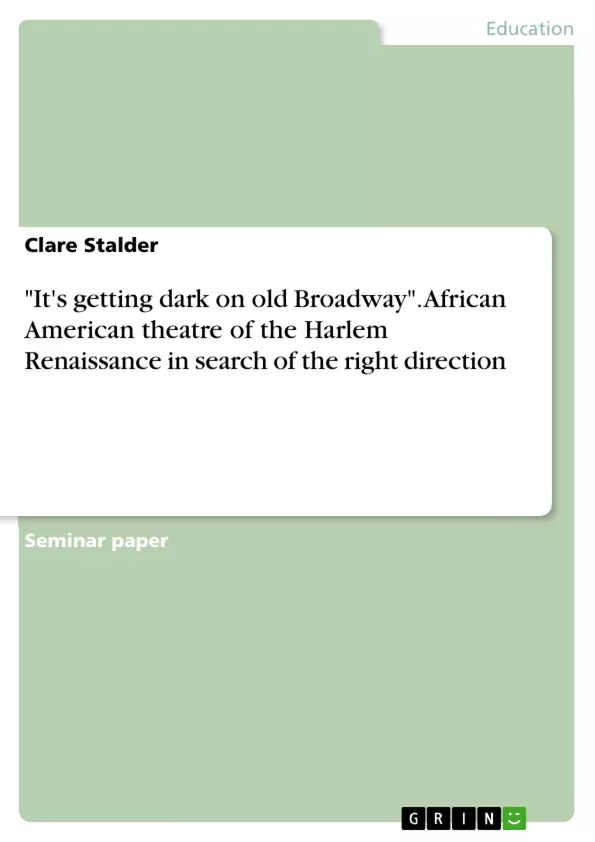[...] When Gilda Gray performed "It's Getting Dark on Old Broadway" in the opening show of the
song-and-dance revue Ziegfeld Follies on 5 June 1922 she eternalized Broadway's latest
trend (Woll 76). Black entertainment proliferated in the Theatre District along Broadway in
the 1920s and it seemed that black shows had made it into the limelight of success. There
was, however, a different 'dark' side to the developments of the black performance scene.
To many leading intellectuals of the Harlem Renaissance, the new darkness on
Broadway looked rather bleak. Important figures like W. E. B. Du Bois who campaigned for a
new racial identity through cultural creation (cf. Du Bois “Criteria of Negro Art”) feared that
the new phenomenon of black productions reaching out for mainstream success would
betray their cause. In his speech at the NAACP's annual conference, he famously claimed
that "all Art is propaganda and ever must be" (Du Bois par. 29). Catering to the white public's
demands (pars. 33, 35), as the successful Black Broadway musicals did, would mean failing
the cause, according to Du Bois. While some scholars argue that theatre and performance in
the New Negro era played "a pivotal role in the evolution of Black Nationalism" (Krasner 1),
those are opposed by a number of authors who look upon the Harlem Renaissance as a
failure (cf. Baker xiii, Neal 39, Krasner 95f.).
In the following paper, I will look into the question of whether the performers and
artists of the Harlem Renaissance really failed to contribute to a change of white America's
attitude toward the African American race (Krasner 14). One point at issue will be whether
the increasing success and commercialisation of Black theatre counteracted the objectives of
racial renewal or if on the contrary, they were a means to an end. [...]
Table of Contents
- Introduction
- Blackface minstrelsy: the ancestors of Black theatre
- Black musical theatre: From Broadway to Harlem nightclubs and back
- The special role of musical theatre
- Vaudeville and the first black musical comedies (1880-1910)
- The Term of Exile (1910-1920)
- Shuffle Along - Back to Broadway (1921-1929)
- Black Drama: In search of the right direction
- Protest drama or folk theatre?
- Folk drama and the Little Theatre movement
- Black drama on Broadway
- Dilemmas of the Black performer: dangers and chances of going mainstream…
- The double audience
- Imitating white material or creating new black material
- White writers and producers staging "black" drama
- Segregation and discrimination
Objectives and Key Themes
This paper explores the development of Black theatre during the Harlem Renaissance, specifically examining whether the increasing success and commercialization of Black theatre contributed to or hindered the movement's goals of racial renewal. It analyzes the challenges faced by Black performers and playwrights in a society riddled with racial prejudice and stereotypes. The paper investigates the legacy of blackface minstrelsy and its impact on Black musical theatre, as well as the struggles of Black drama to find its own voice and direction. Key themes explored include:- The influence of minstrelsy on Black theatre
- The role of musical theatre in achieving both success and societal change
- The challenges faced by Black performers in navigating a racially charged performance landscape
- The search for authentic Black representation on stage
- The complexities of achieving mainstream success while upholding racial identity
Chapter Summaries
The paper begins by examining the legacy of blackface minstrelsy, highlighting its role in perpetuating harmful stereotypes and its impact on early Black musical theatre. It then explores the evolution of Black musical theatre, from its beginnings in vaudeville and the emergence of the first Black musical comedies to the rise of Harlem nightclubs and the subsequent return to Broadway. The chapter discusses the unique role of musical theatre, both as a source of popularity among white audiences and as a genre burdened by the legacy of minstrel stereotypes. The paper then shifts to the challenges faced by Black drama during the Harlem Renaissance, examining the debate between protest drama and folk theatre and the emergence of the Little Theatre movement. It explores the difficulties of gaining a foothold on Broadway and the complex relationship between Black performers and the white audience. The final chapter focuses on the dilemmas faced by Black performers, including the double audience they had to address, the pressures to imitate white material or create new Black material, and the pervasive issue of segregation and discrimination. It examines the impact of white writers and producers staging "black" drama and the ongoing struggle for racial representation and recognition.Keywords
The paper focuses on the intersection of race, performance, and cultural identity during the Harlem Renaissance. Key terms include Black theatre, Harlem Renaissance, blackface minstrelsy, musical theatre, drama, protest drama, folk theatre, Little Theatre movement, racial stereotypes, segregation, discrimination, and mainstream success.- Arbeit zitieren
- Clare Stalder (Autor:in), 2011, "It's getting dark on old Broadway". African American theatre of the Harlem Renaissance in search of the right direction, München, GRIN Verlag, https://www.hausarbeiten.de/document/212985


